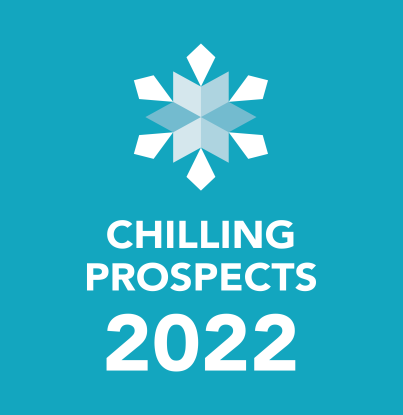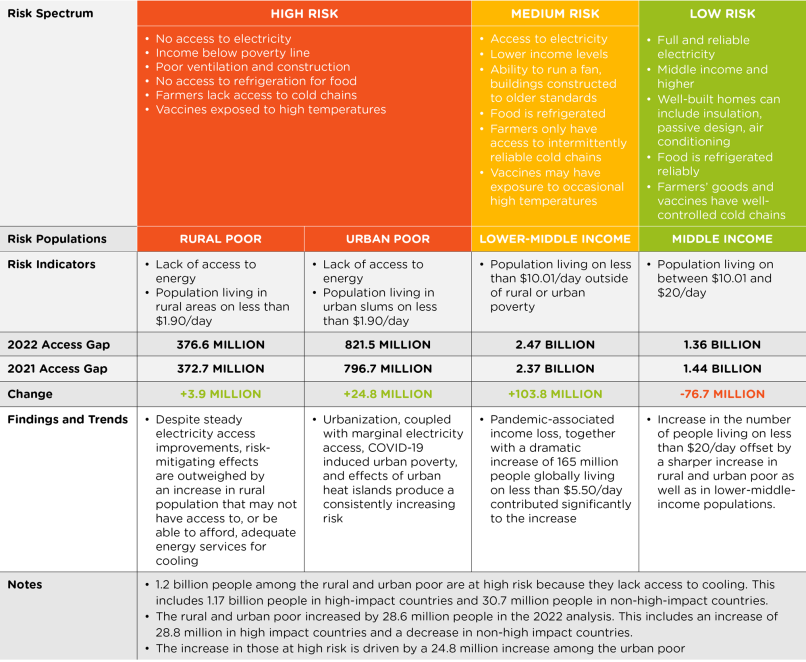Global access to cooling gaps in 2022
 |
Chapter 1.1 Chapter 1 overview |
Key messages
- Around the world, 1.2 billion people in poor rural and urban settings are at high risk because they lack access to cooling. The risks are growing, with 28 million more people at high risk compared to 2021.
- The report finds that 2.47 billion people are among the lower-middle income and 1.36 billion among the middle income, representing a substantial population in need of affordable, efficient, and climate-friendly cooling solutions to make sure we achieve the SDGs and the Paris Agreement.
1.2 bn
rural and urban poor are at high risk because they lack access to cooling, an increase of 28 million compared to last year.
2.47 bn
lower-middle-income people are on the brink of purchasing the most affordable cooling device. Limited purchasing options could cause a dramatic increase in energy consumption and emissions.
Overview
This section examines global cooling access gaps among 54 high-impact countries and the high-temperature regions of 22 countries not considered high impact. It disaggregates between populations at high risk due to a lack of access to cooling (the rural and urban poor), those at medium risk (the lower-middle-income population) and those at low risk (the middle-income population). While most of the populations at high risk are in high-impact countries, efforts to leave no one behind must recognize where risk exists, even in countries not considered high impact. Sections 1.3 and 1.4 disaggregate the data for risk groups between these two country types.
High risk: 1.2 billion people
In 2022, across 54 high-impact countries [1] and high-temperature regions of 22 countries not considered high impact, 1.2 billion rural and urban poor are at high risk because they lack access to cooling. Of this figure, 1.17 billion live in high-impact countries. This represents an increase of more than 28 million people since 2021.
- The number of urban poor at high risk increased by 24.9 million people in high-impact countries, driven by a strong urbanization trend, while there was a reduction in urban poor at risk of 94,000 people in non-high-impact countries.
- The rural poor at high risk grew by nearly 4 million from 372.7 million to 376.6 million, with most of the increase in high-impact countries. This increase was driven by several factors, most notably the economic impact of the COVID-19 pandemic that continued to affect the rural poor, with urbanization offsetting potentially higher growth.
Chilling Prospects 2022 Special: Delivering Cooling for All, SDG7 and Climate ActionPublished in November 2022, this analysis dives deeper into how progress towards SDG 7.2 (renewable energy) and SDG 7.3 (energy efficiency) can reduce the number of people at risk and support achieving SDG13 (climate action). |
Figure 1.1: Population by country at high risk due to a lack of access to cooling
In the Critical 9 countries, [2] the number of people at high risk (rural and urban poor) grew by an average of 7 percent over the last year, with an increase in all countries except for Indonesia. India and China have the largest populations at high risk in absolute numbers (almost 323 million and 159 million, respectively), while Mozambique and Nigeria have the largest relative share of rural and urban poor among the Critical 9 countries, with 84 percent and 67 percent of the total population at high risk respectively.
In the 2022 analysis, the rural poor and urban poor risk groups grew at a faster rate than in previous years. Several factors contributed to this trend, including gaps in access to modern, reliable energy services and the ongoing effects of the COVID-19 pandemic on global extreme poverty. [3] The countries with the most significant proportion of their populations at high risk remain in Africa, and include Guinea-Bissau and Somalia, where over 90 percent of the total population is at high risk, as well as Angola, Benin, Liberia and Mozambique, where over 80 percent is at high risk.
Medium and low risk: 3.83 billion people
The lower-middle-income population at medium risk increased from 2.36 billion to 2.47 billion compared to last year, including an increase of 108.8 million among high-impact countries and a decrease of 5 million among non-high-impact countries. Income loss during the pandemic, in combination with other factors, brought the lower-middle-income population back to similar levels as in 2018, when the access to cooling tracking efforts began. Among this group, it is estimated that in 2021 an additional 165 million people globally lived on less than USD 5.50 per day because of the pandemic, 119 million of them in East and South Asia and the Pacific, 29 million in Africa and the Middle East, and 12 million in Latin America and the Caribbean. [4]
At the same time, the middle-income population at low risk decreased by 76.7 million, from 1.44 billion to 1.36 billion in the 2022 analysis, a figure that includes a 75.7 million person decrease among the high-impact countries.
Access to cooling risks
Across the 54 high-impact countries and 22 non-high-impact countries, at least 3.66 billion people face high or medium risk from some type of cooling access challenge, an increase of 132 million people compared to last year. A further 1.36 billion people are at low risk, but serious risks are still posed by this population to climate and energy systems, where people choose ownership of cooling appliances that are not sustainable.
Table 1.1: Global access to cooling population at risk (for 54-high impact countries and 22 countries not considered high impact)

While higher temperatures and living standards drive demand for cooling, and access to electricity access is a key enabler for cooling services, the ability of households to own and operate appliances largely corresponds to trends in income and urbanization. [5] For example, in India, which has a population of 1.4 billion, despite electricity access having approached 100 percent, cooling appliance ownership remains low, with an estimated ownership of 196 million fans, 162 million refrigerators and 40 million air conditioners.
Figure 1.2: Cooling appliance ownership in the Critical 9 countries
Assessing 20-year historical trends in poverty, electricity access, population and urbanization finds that while progress on electricity access has continued steadily, the global population has increased across all risk groups. This increase has been driven by a variety of factors including trends in population and income growth, urbanization and extreme poverty.
Figure 1.3: Key access to cooling risk indicators (2000–2019)
Notes and references
Each year, the Chilling Prospects report projects an estimate of the current state of access to cooling gaps, based on the best available data and evidence. Chilling Prospects 2022 presents an analysis of cooling access gaps at the beginning of 2022, based on the best available data, primarily 2021 statistics and information.
[1] High-impact countries are those expected to experience sustained high temperatures which also have significant populations at high risk from a lack of access to cooling due to poverty and electricity access gaps. For a full list, see here.
[2] The Critical 9 countries are: Bangladesh, Brazil, China, India, Indonesia, Mozambique, Nigeria, Pakistan and Sudan.
[3] World Bank (2021). COVID-19 leaves a legacy of rising poverty and widening inequality. Link.
[4] World Bank (2021). Poverty, median incomes, and inequality in 2021: a diverging recovery. Link.
[5] Poblete-Cazenave et al. (2021). Global scenarios of household access to modern energy services under climate mitigation policy. Link.
Dollar figures in this report refer to United States Dollars

